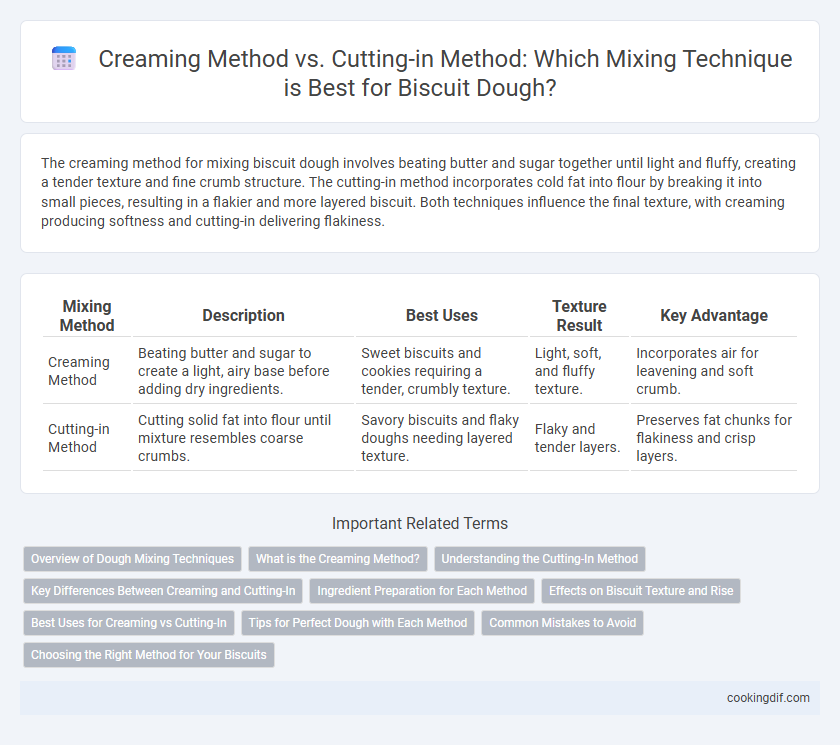The creaming method for mixing biscuit dough involves beating butter and sugar together until light and fluffy, creating a tender texture and fine crumb structure. The cutting-in method incorporates cold fat into flour by breaking it into small pieces, resulting in a flakier and more layered biscuit. Both techniques influence the final texture, with creaming producing softness and cutting-in delivering flakiness.
Table of Comparison
| Mixing Method | Description | Best Uses | Texture Result | Key Advantage |
|---|---|---|---|---|
| Creaming Method | Beating butter and sugar to create a light, airy base before adding dry ingredients. | Sweet biscuits and cookies requiring a tender, crumbly texture. | Light, soft, and fluffy texture. | Incorporates air for leavening and soft crumb. |
| Cutting-in Method | Cutting solid fat into flour until mixture resembles coarse crumbs. | Savory biscuits and flaky doughs needing layered texture. | Flaky and tender layers. | Preserves fat chunks for flakiness and crisp layers. |
Overview of Dough Mixing Techniques
The creaming method involves beating fat and sugar together until light and fluffy, creating aeration that results in a tender biscuit crumb. The cutting-in method distributes solid fat into flour using a pastry cutter or fingers, producing a flaky texture by creating small fat pockets that steam during baking. Both techniques control gluten development differently to achieve distinct biscuit textures.
What is the Creaming Method?
The creaming method involves beating sugar and fat together until light and fluffy, creating air pockets that help leaven the biscuit dough. This process produces a tender, soft crumb by incorporating trapped air into the mixture before adding dry ingredients. Creaming is ideal for tender biscuits requiring a fine, uniform texture and slight rise.
Understanding the Cutting-In Method
The cutting-in method involves incorporating cold fat into flour by using a pastry cutter or two knives to create a coarse mixture with small pea-sized pieces of fat. This technique helps maintain distinct layers within the dough, resulting in a flaky, tender biscuit texture by preventing the fat from fully blending into the flour. Unlike the creaming method, which blends fat and sugar until smooth, cutting-in focuses on preserving the fat's structure to produce biscuits with optimal rise and flakiness.
Key Differences Between Creaming and Cutting-In
The creaming method involves beating fat and sugar together until light and fluffy, creating air pockets that contribute to a tender biscuit texture. In contrast, the cutting-in method incorporates cold fat into the flour using a pastry cutter or fingers, resulting in a coarser mixture that produces flaky layers. Key differences include the temperature of the fat, the texture of the dough, and the final biscuit crumb structure, with creaming favoring softness and cutting-in enhancing flakiness.
Ingredient Preparation for Each Method
The creaming method begins by beating butter and sugar together until light and fluffy, creating an aerated base that enhances leavening and texture. In contrast, the cutting-in method involves incorporating cold fat into dry ingredients, using a pastry cutter or fingers to create pea-sized fat pieces that promote flakiness in the biscuit. Proper temperature control and fat distribution are critical in each method to achieve the desired biscuit crumb and tenderness.
Effects on Biscuit Texture and Rise
The creaming method incorporates air into the dough by beating fat and sugar together, resulting in biscuits with a lighter texture and greater rise due to improved leavening. In contrast, the cutting-in method distributes solid fat into the flour, creating distinct fat pockets that produce a flakier biscuit texture with a more controlled, modest rise. Choosing between these techniques directly influences the biscuit's crumb structure and overall tenderness.
Best Uses for Creaming vs Cutting-In
The creaming method excels in recipes requiring a light, airy texture, ideal for cake-like biscuits where incorporating air is essential. In contrast, the cutting-in method is best suited for flaky, tender biscuits by evenly distributing fat into flour, creating layers and crumbly texture. Choosing creaming produces softer, more cake-like biscuits, while cutting-in yields flaky, buttery results perfect for classic biscuits and scones.
Tips for Perfect Dough with Each Method
For perfect biscuit dough using the creaming method, ensure butter is softened and beat it thoroughly with sugar to incorporate air, creating a light texture. When applying the cutting-in method, use chilled butter and cut it into the flour until pea-sized pieces remain, preserving flakiness by preventing overmixing. Always chill the dough before baking to maintain structure and achieve tender, flaky biscuits.
Common Mistakes to Avoid
Overmixing dough in the creaming method can lead to dense, tough biscuits by developing too much gluten, while undercreaming results in uneven texture and poor rise. In the cutting-in method, failing to keep fats cold or overworking the dough causes greasy, flat biscuits lacking flakiness. Avoiding these mistakes ensures light, tender biscuits with the desired crumb structure and flaky layers.
Choosing the Right Method for Your Biscuits
Choosing the right mixing method significantly affects biscuit texture and flakiness. The creaming method incorporates air by beating butter and sugar together, resulting in a tender, cake-like crumb ideal for soft biscuits. In contrast, the cutting-in method combines cold fat into flour, creating distinct layers and a flaky texture perfect for traditional biscuits.
Creaming method vs Cutting-in method for mixing dough Infographic

 cookingdif.com
cookingdif.com